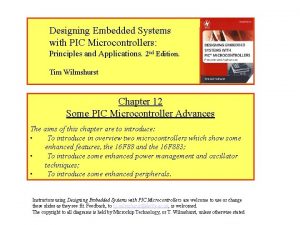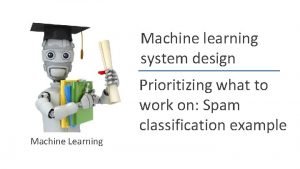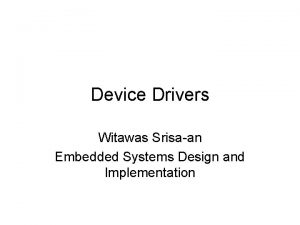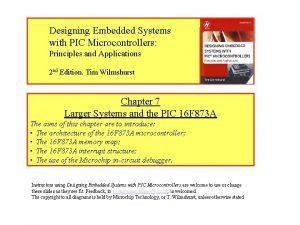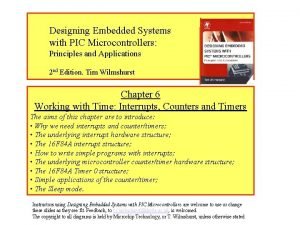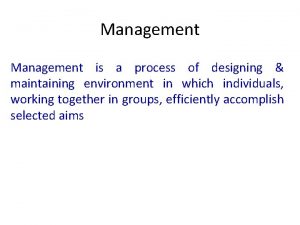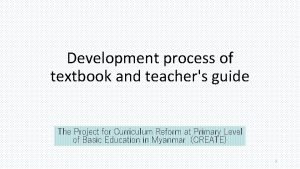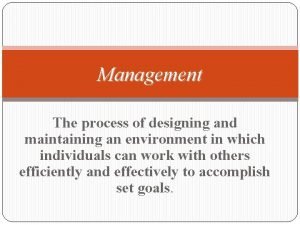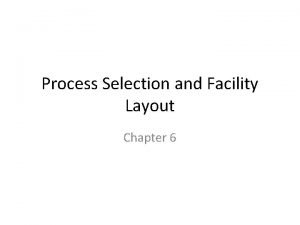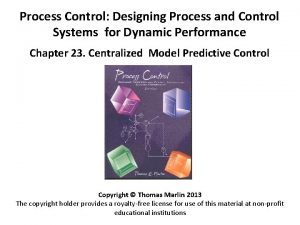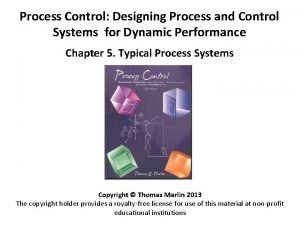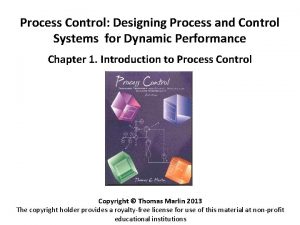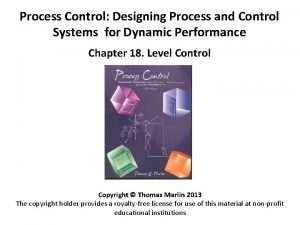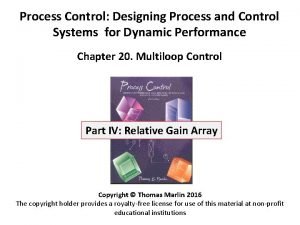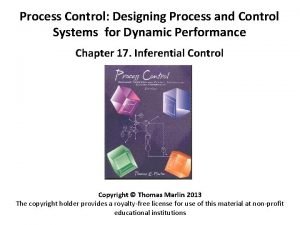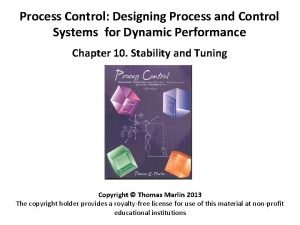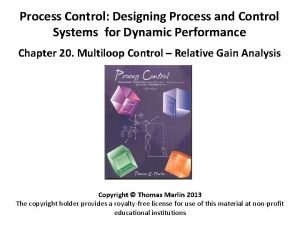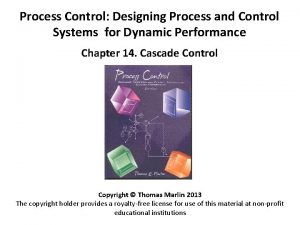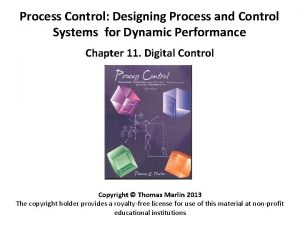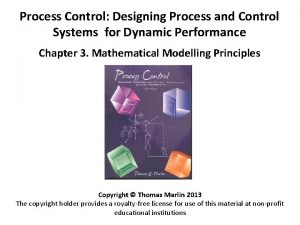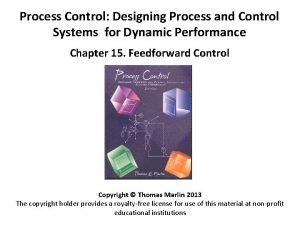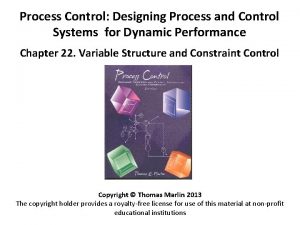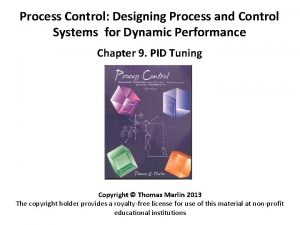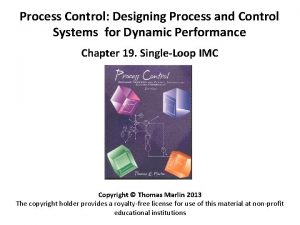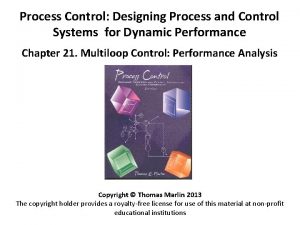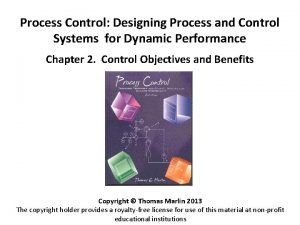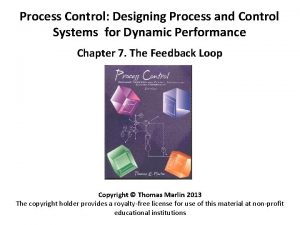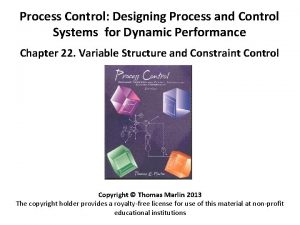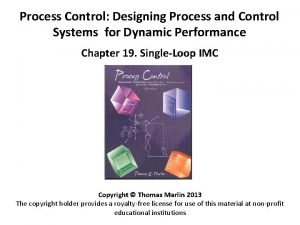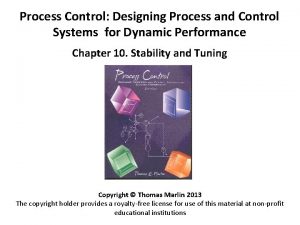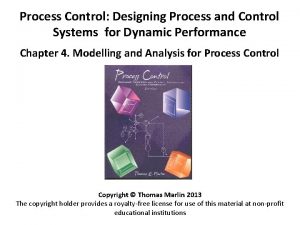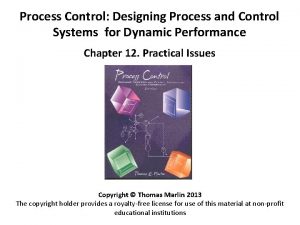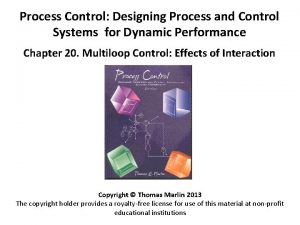Process Control Designing Process and Control Systems for





























































- Slides: 61

Process Control: Designing Process and Control Systems for Dynamic Performance Chapter 24. Process Control Design: Definition and Decisions Copyright © Thomas Marlin 2013 The copyright holder provides a royalty-free license for use of this material at non-profit educational institutions

CHAPTER 24: CONTROL DESIGN When I complete this chapter, I want to be able to do the following. • Define the control problem • Evaluate if desired performance is possible; if not, modify process • Select instrumentation • Design loop pairing for control • Provide sensors for process monitoring

CHAPTER 24: CONTROL DESIGN Outline of the lesson. THE CONTROL DESIGN PROCEDURE • Define the control problem (challenge) • Evaluate/achieve operability - Degrees of freedom - Controllability - Operating Window • Process dynamics for good performance • Loop pairing • Control for safety • Monitoring and diagnosis

CHAPTER 24: CONTROL DESIGN Let’s design controls for this process • How do we start? • What are the common steps? • When are we finished? T 6 Let’s review the process Feed Methane Ethane (LK) Propane Butane Pentane T 1 P 1000 k. Pa T 298 K T 4 F 2 P 1 T 5 T 2 F 1 Vapor product T 3 L 1 F 3 A 1 Process fluid Steam L. Key Liquid product

CHAPTER 24: CONTROL DESIGN Design is a goal-oriented task. We must determine the goals before we start to design. This is consistent with the problem solving methods used widely in engineering education. • Woods, Donald, Problem Based Learning: How to Gain the Most from PBL, Griffin Printing, Hamilton, Ontario, 1994. • Fogler, H. Scott and Steve Le. Blanc, Strategies for Creative Problem Solving, Prentice Hall PTR, Upper Saddle River, 1995. We will use the Control Design Form to summarize the problem definition. Danger, sharks!

CHAPTER 24: CONTROL DESIGN 1. Safety WORKSHOP: Define at least one for each category. But, do not design the controls (yet)! 2. Environmental protection Control Design Form 3. Equipment protection Vapor product 4. Smooth operation Objectives 5. Product quality 6. Profit Measurements 7. Monitoring and diagnosis T 6 P 1 Manipulated variables T 4 Constraints T 1 T 2 F 1 T 5 Disturbances L 1 Dynamic responses Additional considerations T 3 F 2 F 3 A 1 Process fluid Steam L. Key Liquid product

CHAPTER 24: CONTROL DESIGN 1. Safety Well done! Now find some more and check the textbook. Maintain vessel pressure below 1200 k. Pa Vapor product 2. Environmental protection Prevent release of hydrocarbons to the atmosphere 3. Equipment protection T 6 P 1 Ensure that liquid flows through the pump T 4 4. Smooth operation When possible, make slow adjustments to liquid product flow rate 5. Product quality Maintain the liquid product at 10 1 mole% L. Key. T 1 T 2 F 1 T 5 L 1 6. Profit Maximize the use of the expensive steam for heating T 3 F 2 F 3 7. Monitoring and diagnosis Provide alarms for immediate attention by operating personnel A 1 Process fluid Steam L. Key Liquid product

CHAPTER 24: CONTROL DESIGN WORKSHOP: Propose sensors for one F, T, P, L measurement. Sensors to achieve objectives Control Design Form • Feasibility Vapor product • Accuracy Objectives • Reproducibility • Dynamics Measurements • Reliability T 6 P 1 • Cost Manipulated variables T 4 Constraints T 1 T 2 F 1 T 5 Disturbances L 1 Dynamic responses Additional considerations T 3 F 2 F 3 A 1 Process fluid Steam L. Key Liquid product

CHAPTER 24: CONTROL DESIGN WORKSHOP: Propose sensors for one F, T, P, L measurement. Sensors • Feasibility Vapor product • Accuracy • Reproducibility • Dynamics T 6 • Reliability P 1 Flexible diaphraghm with capacitance to measure deflection • Cost T 4 Thermocouple T 1 T 5 T 2 Pressure differential X F 1 T 5 L 1 T 3 Orifice plate F 2 F 3 Process fluid Steam Typically, the. A 1 sensor range. Liquid covers the expected product values of the variable (including disturbances), but L. Key not more. An orifice meter would typically read the design value at ~ 70% of its maximum range.

CHAPTER 24: CONTROL DESIGN Low cost Low accuracy OK reproducibility High cost High accuracy High reproducibility heating stream We need to balance cost and accuracy. Which sensors require high accuracy? F 2 MV 2 F 1 feed T 1 AY 2 feedforward MVff T 2 CV 2 A 2 TY 3 TC 3 secondary MV 1 packed bed reactor primary CV 1 AC 1 SP 1 from person

CHAPTER 24: CONTROL DESIGN FINAL ELEMENTS WORKSHOP: • Define failure position (as best possible, without the remainder of plant design). • Select the body for a valve • Capacity • Precision Control Design Form • Range Vapor product • Characteristic Objectives • Failure position • Dynamics Measurements • Reliability T 6 P 1 • Cost Manipulated variables T 4 Constraints T 1 T 2 F 1 T 5 Disturbances L 1 Dynamic responses Additional considerations T 3 F 2 F 3 A 1 Process fluid Steam L. Key Liquid product

CHAPTER 24: CONTROL DESIGN FINAL ELEMENTS WORKSHOP: • Define failure position (as best possible, without the remainder of plant design). • Select the body for a valve • Capacity • Precision • Range Vapor product • Characteristic • Failure position • Dynamics • Reliability T 6 P 1 • Cost T 4 T 1 T 2 F 1 T 5 Globe valve for clean fluid with moderate pressure loss acceptable. L 1 T 3 F 2 F 3 The maximum flow should occur near 100% valve opening. Remember to consider all Steam Process operating conditions! fluid Fail opened to relieve pressure in vessel. (we assume that the downstream unit can accept the material and not release. ) A 1 L. Key Liquid product

CHAPTER 24: CONTROL DESIGN WORKSHOP: Determine some constraints Control Design Form CONSTRAINTS Vapor product • Safety Objectives • Equipment protection - Short term Measurements - Long term T 6 • Product quality P 1 Manipulated variables T 4 Constraints T 1 T 2 F 1 T 5 Disturbances L 1 Dynamic responses Additional considerations T 3 F 2 F 3 A 1 Process fluid Steam L. Key Liquid product

CHAPTER 24: CONTROL DESIGN CONSTRAINTS • Safety WORKSHOP: Determine some constraints • Operating range of equipment Vapor product • Equipment protection - Short term - Long term • Product quality T 6 P 1 Pressure less than maximum for safety T 4 T 1 T 5 T 2 F 1 T 5 L 1 Liquid should not file the vessel and exit through the top pipe. T 3 F 2 F 3 A 1 Process fluid Steam L. Key Liquid product

CHAPTER 24: CONTROL DESIGN WORKSHOP: Determine some likely disturbances Control Design Form DISTURBANCES Vapor product • Variables Objectives • Magnitude • Sign Measurements • Frequency T 6 P 1 Manipulated variables T 4 Constraints T 1 T 2 F 1 T 5 Disturbances L 1 Dynamic responses Additional considerations T 3 F 2 F 3 A 1 Process fluid Steam L. Key Liquid product

CHAPTER 24: CONTROL DESIGN DISTURBANCES WORKSHOP: Determine some likely disturbances • Variables • Magnitude Vapor product • Sign • Frequency Why is this important? FEED COMPOSITION • Due to upstream processing • Components change in a correlated manner T 6 P 1 T 4 T 1 T 2 F 1 T 5 • Magnitude is estimated T 5 L 1 T 3 F 2 F 3 A 1 Process fluid Steam L. Key Liquid product

CHAPTER 24: CONTROL DESIGN WORKSHOP: How would you use models in control design? Control Design Form DYNAMIC MODELS Vapor product • Fundamental modelling Objectives • Empirical identification Measurements T 6 P 1 Manipulated variables T 4 Constraints T 1 T 2 F 1 T 5 Disturbances L 1 Dynamic responses Additional considerations T 3 F 2 F 3 A 1 Process fluid Steam L. Key Liquid product

CHAPTER 24: CONTROL DESIGN THE CONTROL DESIGN PROCEDURE • Define the control problem (challenge) • Evaluate/achieve operability - Degrees of freedom - Controllability - Operating Window • Process dynamics for good performance • Loop pairing • Control for safety • Monitoring and diagnosis

CHAPTER 24: CONTROL DESIGN DYNAMIC MODELS WORKSHOP: How would you use models in control design? • Fundamental modelling • Empirical identification Vapor product T 6 P 1 T 4 T 1 T 2 F 1 T 5 L 1 T 3 F 2 F 3 A 1 Process fluid Steam L. Key Liquid product

CHAPTER 24: CONTROL DESIGN DYNAMIC MODELS WORKSHOP: How would you use models in control design? • Fundamental modelling • Empirical identification Vapor product T 6 P 1 • Determining controllability • Estimating operating windows T 4 T 1 T 2 F 1 T 5 • Pairing loops • Tuning controllers Models required, do not design entirely on qualitative model. L 1 T 3 F 2 F 3 A 1 Process fluid Steam L. Key Liquid product

CHAPTER 24: CONTROL DESIGN PROCESS OPERABILITY • Degrees of freedom • Controllability • Operating Window Is control possible given the manipulated and control variables? If not, the process (or objectives) must be changed Inputs Manipulated variables Outputs final element sensor PROCESS Disturbances variables Controlled variables, related to control objectives Majority of variables remain unmeasured

CHAPTER 24: CONTROL DESIGN DEGRESS OF FREEDOM QUICK REVIEW: The system is has sufficient degrees of freedom if # of manipulated variables # of controlled variables Inputs Manipulated variables Outputs final element sensor PROCESS Disturbances variables Controlled variables, related to control objectives Majority of variables remain unmeasured

CHAPTER 24: CONTROL DESIGN CONTROLLABILITY QUICK REVIEW: Controllability ensures that the selected controlled variables can be changed to desired values The system is controllable if Det [Kp] 0 Inputs Manipulated variables final element Outputs [Kp] PROCESS Disturbances variables sensor Controlled variables, related to control objectives Majority of variables remain unmeasured

CHAPTER 24: CONTROL DESIGN CONTROLLABILITY QUICK REVIEW: Controllability ensures that the selected controlled variables can be changed to desired values Manipulated variables final element [Kp] sensor Controlled variables, related to control objectives Why might we come to an incorrect result from qualitative analysis? Some seemingly independent variables are “linked” through • material balance • energy balance • equilibrium • reaction stoichiometry

CHAPTER 24: CONTROL DESIGN OPERATING WINDOW QUICK REVIEW: This is the “reachable” region of steady-state values as disturbances occur and set points are changed. • Covers a wide range - linear models not usually adequate • Sometimes called the feasible region • Usually plotted in one of the forms sketched below Constant disturbances Set point 2 Disturbance 2 Constant set points Disturbance 1 Set point 1

CHAPTER 24: CONTROL DESIGN DEGRESS OF FREEDOM Vapor product What is the maximum number of variables that can be controlled? T 6 P 1 T 4 T 1 T 2 F 1 T 5 L 1 T 3 F 2 F 3 A 1 Process fluid Steam L. Key Liquid product

CHAPTER 24: CONTROL DESIGN DEGRESS OF FREEDOM Vapor product What is the maximum number of variables that can be controlled? T 6 P 1 T 4 Can we control any combination of variables? T 1 T 2 F 1 T 5 L 1 T 3 F 2 F 3 A 1 Process fluid Steam L. Key Liquid product

CHAPTER 24: CONTROL DESIGN CONTROLLABILITY Vapor product • Which variables do we want to control? • Can we control these with the valves shown? T 6 v 5 P 1 T 4 T 1 T 2 F 1 T 5 Let’s select: F 1 production rate T 6 feed vaporization v 1 A 1 product quality F 2 P 1 safety L 1 liquid to pump v 3 L 1 v 2 T 3 F 3 v 4 A 1 Process fluid Steam L. Key Liquid product

CHAPTER 24: CONTROL DESIGN CONTROLLABILITY • Can we control these with the valves shown, i. e. , is the system controllable? Let’s select: F 1 production rate T 6 feed vaporization A 1 product quality P 1 safety L 1 liquid to pump

CHAPTER 24: CONTROL DESIGN CONTROLLABILITY • Can we control these with the valves shown, i. e. , is the system controllable? The effects of v 1 and v 2 are identical, within a constant. Therefore, the five CVs cannot be independently affected by the five valves. Let’s select: F 1 production rate T 6 feed vaporization A 1 product quality P 1 safety L 1 liquid to pump Det [KP] = 10 -7

CHAPTER 24: CONTROL DESIGN CONTROLLABILITY • Can we control these with the valves shown, i. e. , is the system controllable? The effects of v 1 and v 2 are identical, within a constant. Therefore, the five CVs cannot be independently affected by the five valves. T 2 v 1 A 1 Let’s select: F 1 production rate T 6 feed vaporization A 1 product quality P 1 safety L 1 liquid to pump P 1 v 2 T 6 s. L 1 Both v 1 and v 2 affect CVs of interest through T 6. This is a contraction that reduces the controllability.

CHAPTER 24: CONTROL DESIGN CONTROLLABILITY • Can we control these with the valves shown, i. e. , is the system controllable? The effects of v 1 and v 2 are identical, within a constant. Here, we remove v 1 (arbitrarily). Yes, controllable! Let’s select: F 1 production rate T 6 feed vaporization A 1 product quality P 1 safety L 1 liquid to pump Det [KP] = 10 -1 0

CHAPTER 24: CONTROL DESIGN OPERATING WINDOW Vapor product Can we achieve the desired set points for any values of process disturbances? T 6 v 5 P 1 T 4 T 1 T 2 F 1 T 5 v 3 L 1 v 2 T 3 F 2 F 3 v 4 A 1 Process fluid Steam L. Key Liquid product

CHAPTER 24: CONTROL DESIGN OPERATING WINDOW To achieve this large window, both v 1 and v 2 must be adjusted. We will take this into consideration when we complete the design. feasible

CHAPTER 24: CONTROL DESIGN THE CONTROL DESIGN PROCEDURE • Define the control problem (challenge) • Evaluate/achieve operability - Degrees of freedom - Controllability - Operating Window • Process dynamics for good performance • Loop pairing • Control for safety • Monitoring and diagnosis

CHAPTER 24: CONTROL DESIGN DYNAMICS FOR GOOD PERFORMANCE • The importance of disturbance dynamics - Large time constants decrease the effect of the disturbance on the controller variable - Dead time has no effect • The importance of feedback dynamics - Large dead times and time constants are bad!! • The importance of the disturbance frequency - Low frequencies are easy to control. Critical frequency cannot be controlled.

CHAPTER 24: CONTROL DESIGN What process changes are appropriate for this process?

CHAPTER 24: CONTROL DESIGN Small inventory for fast feedback By-pass to control preheat, reduce disturbances from bottoms Averaging level control to smooth flow to downstream process

CHAPTER 24: CONTROL DESIGN THE CONTROL DESIGN PROCEDURE • Define the control problem (challenge) • Evaluate/achieve operability - Degrees of freedom - Controllability - Operating Window • Process dynamics for good performance • Loop pairing • Control for safety • Monitoring and diagnosis

CHAPTER 24: CONTROL DESIGN LOOP PAIRING QUALITATIVE GUIDELINES • CVi - MVj pairing that has strong effect (large Kp) • CVi - MVj pairing that has fast dynamics • CVi - MVj pairing that has large range (MV min to max) • CVi - MVj pairing with causal relationship that is independent of other loops • Adjust MVj that has lowest cost; keep high cost MV near zero Often, these guidelines cannot all be satisfied. In some cases, they must be violated to achieve good performance. See the next slide for quantitative metrics for control design.

CHAPTER 24: CONTROL DESIGN REQUIRED: DOF, Controllability, Operating Window HIGHLY DESIRED We have seen analysis methods in Chapter 21. • Integrity - Performance is “acceptable after one or more controllers become inactive (RGA) • Control performance - CVs achieve zero offset and low deviations from SP - MVs have acceptable dynamic variability • Robustness - Performance (not just stability) is achieved for a range of plant dynamics • Range - Strong effect to compensate large disturbances

CHAPTER 24: CONTROL DESIGN Let’s evaluate the Relative Gain Array, which can be used to evaluate integrity. Vapor product T 6 v 5 P 1 T 4 Interpret the pairings that yield good integrity. T 1 T 2 F 1 T 5 v 1 F 2 T 5 v 3 L 1 v 2 T 3 F 3 A 1 Process fluid Steam L. Key v 4 Liquid product

CHAPTER 24: CONTROL DESIGN THE CONTROL DESIGN PROCEDURE • Define the control problem (challenge) • Evaluate/achieve operability - Degrees of freedom - Controllability - Operating Window • Process dynamics for good performance • Loop pairing • Control for safety • Monitoring and diagnosis

CHAPTER 24: CONTROL DESIGN CONTROL FOR SAFETY EMERGENCY RESPONSE Strength in Reserve CONTAINMENT RELIEF SIS ALARMS BPCT • BPCT - Basic process control • Alarms - draw attention • SIS - Safety interlock system to stop/start equipment • Relief - Prevent excessive pressure • Containment - Prevent materials from reaching community or environment See extra lecture on “Control for Safety”

CHAPTER 24: CONTROL DESIGN THE CONTROL DESIGN PROCEDURE • Define the control problem (challenge) • Evaluate/achieve operability - Degrees of freedom - Controllability - Operating Window • Process dynamics for good performance • Loop pairing • Control for safety • Monitoring and diagnosis

CHAPTER 24: CONTROL DESIGN People monitor and diagnose the plant and control system. They are responsible for intervening quickly when needed and for planning non-critical maintenance corrections. Central control room Sensors, local indicators, and valves in the process Displays of variables, calculations, and commands to valves are in the centralized control center.

CHAPTER 24: CONTROL DESIGN LOCAL INSTRUMENTATION Local manipulated variables are needed for start-up, shutdown, and actions taken infrequently. Central control room Local displays are needed by plant operators when working at the process equipment, e. g. , starting a pump or opening a manual by-pass. They are also used for longer-term monitoring of slow changes, when shift or daily measurements are OK.

CHAPTER 24: CONTROL DESIGN SHORT-TERM DATA ANALYSIS The centralized control room provides information on the integrated plant. • Trouble shooting • product quality • production control Information must be presented in a easily understood manner, graphically in context with process schematics. Mainly used by plant operators. Central control room

CHAPTER 24: CONTROL DESIGN LONGER-TERM DATA ANALYSIS The centralized control room provides information on the integrated plant. • Process performance (energy/kg of product) • Equipment performance (compressor efficiency, heat exchanger fouling, etc. ) Information must be in a format that can be used by other programs. Mainly used by engineers. Central control room

CHAPTER 24: CONTROL DESIGN THE CONTROL DESIGN PROCEDURE • Define the control problem (challenge) • Evaluate/achieve operability - Degrees of freedom - Controllability - Operating Window • Process dynamics for good performance • Loop pairing • Control for safety • Monitoring and diagnosis

CHAPTER 24: CONTROL DESIGN Let’s design controls for this process! T 6 Feed Methane Ethane (LK) Propane Butane Pentane T 1 P 1000 k. Pa T 5 T 2 T 298 K F 1 T 3 F 2 Vapor product L 1 F 3 A 1 Process fluid Steam L. Key Liquid product

CHAPTER 24: CONTROL DESIGN cascade PAH Split range Feed Methane Ethane (LK) Propane Butane Pentane T 1 PC-1 T 5 T 2 LAL LAH FC-1 F 2 TC-6 Vapor product T 3 LC-1 F 3 AC-1 Process fluid Steam L. Key Liquid product

Response of design to a step change in feed composition

CHAPTER 24: CONTROL DESIGN WORKSHOP 1 Determine the operating window for the three-tank mixer. Plot the set point of effluent concentration and the feed flow. Base case data is summarized in the figure and further information is available in Example 7. 2. 50% open FS solvent 6. 9 m 3/min 1% A 50% open pure A FA 0. 14 m 3/min 7. 0 m 3 3% A 7. 0 m 3 AC

CHAPTER 24: CONTROL DESIGN WORKSHOP 2 Discuss how the concepts of partial control were used in design controls for the flash process. (Note, safety elements not shown on diagram. ) See Chapter 24 for partial control. cascade Split range Feed Methane Ethane (LK) Propane Butane Pentane T 1 PC-1 PAH Vapor product T 5 T 2 FC-1 F 2 TC-6 LAL LAH T 3 LC-1 F 3 AC-1 Process fluid Steam L. Key Liquid product

CHAPTER 24: CONTROL DESIGN WORKSHOP 3 Give a process example for a situation in which each of the factors below affect the controllability of a process. See lecture slides for Chapter 20 as a refresher. Some seemingly independent variables are “linked” through • material balance • energy balance • equilibrium • reaction stoichiometry Connected by beam F v 1 L T A CA v 2 F

CHAPTER 24: CONTROL DESIGN WORKSHOP 4 Develop a control design form for the fired heater in the figure. Flue gas feed product air fuel

CHAPTER 24: CONTROL DESIGN WORKSHOP 4 When I complete this chapter, I want to be able to do the following. • Define the control problem • Evaluate if desired performance is possible; if not, modify process • Select instrumentation • Design loop pairing for control • Provide sensors for process monitoring Lot’s of improvement, but we need some more study! • Read the textbook • Review the notes, especially learning goals and workshop • Try out the self-study suggestions • Naturally, we’ll have an assignment!

CHAPTER 24: LEARNING RESOURCES • SITE PC-EDUCATION WEB - Textbook, Chapter 24 - Interactive Learning Module (Chapter 2) - Tutorials (Chapter 24) • Other views of control design - Luyben, W. , Tyreus, B. and Luyben, M. , Plantwide Process Control, Mc. Graw-Hill, New York, 1999

CHAPTER 24: SUGGESTIONS FOR SELF-STUDY 1. Compare the control design procedure presented here with the design procedure that you learned in your process design course. 2. Discuss how you could evaluate the steady-state controllability of a process using a flowsheeting program (such as ASPEN, HYSYS, or PROII). 3. Review the bonus lecture slides for Control for Safety. Apply the safety principles to the fired heater example in Workshop 4.

CHAPTER 24: SUGGESTIONS FOR SELF-STUDY 4. Search the WWW for information on the control design for a process of interest to you. - Separation (distillation, membrane, settling) - Chemical Reactor - Biological reactor (waste water treating or pasteurization) - Rotating equipment (pump or compressor) - Heat exchanger - Flow and pressure system - Combustion system
 Designing embedded systems with pic microcontrollers
Designing embedded systems with pic microcontrollers Machine learning system design examples
Machine learning system design examples Designing device drivers for embedded systems
Designing device drivers for embedded systems Data memory
Data memory Designing embedded systems with pic microcontrollers
Designing embedded systems with pic microcontrollers The process of designing and maintaining an environment
The process of designing and maintaining an environment Process of textbook designing and development
Process of textbook designing and development The process of designing and maintaining an environment
The process of designing and maintaining an environment Process selection and facility layout
Process selection and facility layout The main issue in designing process layouts concerns what
The main issue in designing process layouts concerns what Systemactio
Systemactio Distinguish between process control and product control
Distinguish between process control and product control Kontinuitetshantering i praktiken
Kontinuitetshantering i praktiken Novell typiska drag
Novell typiska drag Nationell inriktning för artificiell intelligens
Nationell inriktning för artificiell intelligens Returpilarna
Returpilarna Shingelfrisyren
Shingelfrisyren En lathund för arbete med kontinuitetshantering
En lathund för arbete med kontinuitetshantering Adressändring ideell förening
Adressändring ideell förening Tidbok yrkesförare
Tidbok yrkesförare Anatomi organ reproduksi
Anatomi organ reproduksi Vad är densitet
Vad är densitet Datorkunskap för nybörjare
Datorkunskap för nybörjare Boverket ka
Boverket ka Debatt mall
Debatt mall Autokratiskt ledarskap
Autokratiskt ledarskap Nyckelkompetenser för livslångt lärande
Nyckelkompetenser för livslångt lärande Påbyggnader för flakfordon
Påbyggnader för flakfordon Lufttryck formel
Lufttryck formel Publik sektor
Publik sektor Jag har nigit för nymånens skära
Jag har nigit för nymånens skära Presentera för publik crossboss
Presentera för publik crossboss Argument för teckenspråk som minoritetsspråk
Argument för teckenspråk som minoritetsspråk Vem räknas som jude
Vem räknas som jude Treserva lathund
Treserva lathund Mjälthilus
Mjälthilus Claes martinsson
Claes martinsson Centrum för kunskap och säkerhet
Centrum för kunskap och säkerhet Byggprocessen steg för steg
Byggprocessen steg för steg Mat för idrottare
Mat för idrottare Verktyg för automatisering av utbetalningar
Verktyg för automatisering av utbetalningar Rutin för avvikelsehantering
Rutin för avvikelsehantering Smärtskolan kunskap för livet
Smärtskolan kunskap för livet Ministerstyre för och nackdelar
Ministerstyre för och nackdelar Tack för att ni har lyssnat
Tack för att ni har lyssnat Mall för referat
Mall för referat Redogör för vad psykologi är
Redogör för vad psykologi är Borstål, egenskaper
Borstål, egenskaper Tack för att ni har lyssnat
Tack för att ni har lyssnat Borra hål för knoppar
Borra hål för knoppar Vilken grundregel finns det för tronföljden i sverige?
Vilken grundregel finns det för tronföljden i sverige? Beräkna standardavvikelse
Beräkna standardavvikelse Tack för att ni har lyssnat
Tack för att ni har lyssnat Steg för steg rita
Steg för steg rita Verksamhetsanalys exempel
Verksamhetsanalys exempel Tobinskatten för och nackdelar
Tobinskatten för och nackdelar Blomman för dagen drog
Blomman för dagen drog Gibbs reflekterande cykel
Gibbs reflekterande cykel Egg för emanuel
Egg för emanuel Elektronik för barn
Elektronik för barn Vad kallas den mantel som bars av kvinnor i antikens rom
Vad kallas den mantel som bars av kvinnor i antikens rom Strategi för svensk viltförvaltning
Strategi för svensk viltförvaltning
